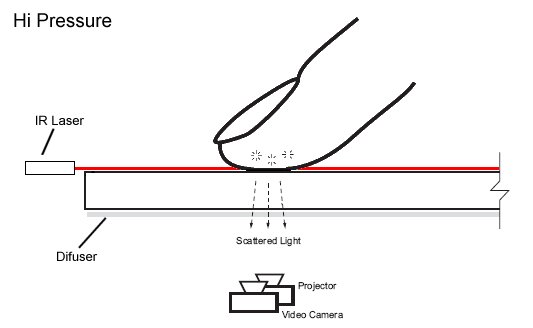
The first is called FTIR, which stands for Frustrated Total Internal Reflection. Basically, you take a piece of acrylic, line it with infrared LEDs, and put an infrared camera or modified webcam underneath to record where you touch it. The infrared LEDs send light into the acrylic, and it gets bounced around inside (total internal reflection) until you touch it (frustrate it). Touching the acrylic causes light to scatter downwards at that point, and the camera sees that light. The downsides are that it can't differentiate objects placed on the surface (marked with fudicals) and fingers, so if you wanted it to, say, connect with your cell when you put it on the table it wouldn't work unless you did it manually. You also seem to need a compliant surface (like silicon) in order for it to be sensitive enough to your touch (unless you have super oily fingers). However, you don't have to enclose it in a box (making it more flexible) and I've been told it's pretty reliable.

Another is called DI (Diffused Illumination). There are two kinds, front DI and rear DI. In both of them, however, you shine a light on a surface, which has something on or under it (even just a piece of paper) to make the light more even. This is called a diffuser. When you place you hand on the surface, it either reflects the light (if it is illuminated from below, called rear DI) or casts shadows on the surface (if it is illuminated from above, called front DI). However, it's difficult to get even illumination with both kinds of set ups, and there's a greater chance of the software picking up 'blobs' or touch points that aren't there. Because of the illumination, it needs to be enclosed in a box as well. Also, front DI is not very reliable because you have to rely on your ambient environment (and it can't pick up fudicals). On the plus side, rear DI is able to recognize fucidals, you can use any material (not just acrylic), and it's supposed to be a really easy set up.

There's a combination of the above two techniques, known as DSI (Diffused Surface Illumination). It's set up the same as FTIR, except it uses a special kind of acrylic known as Endlighten. The Endlighten has particles in it which act like thousands of tiny mirrors, ensuring that the infrared light is spread evenly through the surface. Because this kind of acrylic is so soft, you don't need a compliant layer. Also, since the camera is looking for the reflection of the infrared light you can use fudicals and object recognition. The only downside to this method seems to be that the acrylic costs more than normal acrylic, and the blobs aren't as distinct as those you get using FTIR (they're similar to the blobs you get from DI).

The final technique that I know of is called LLP or LED-LP (Laser Light Plane or LED Light Plane). In this case the camera detects where your fingers penetrate a light plane created just above the surface by either lasers or infrared LED lights. The result is really easily definable blobs, but you can't do any object recognition with it and if your light plane is too thick or too far above the touch surface stray fingers may cause unnecessary blobs. Also, lasers are kind of dangerous, in my opinion. :/
After reviewing the above methods, should I build a multitouch table I'll probably decide to go with DSI, because although the acrylic costs a little more I feel it will be worth it in the end to be able to mess around with object recognition, and it's a lot more reliable than either rear or front DI.
Before I do that, however, I'll probably try doing an MTmini, just so I get a feel of what this is all about. More on that later. :)
-Crystal
(Pictures from nuigroup.com)